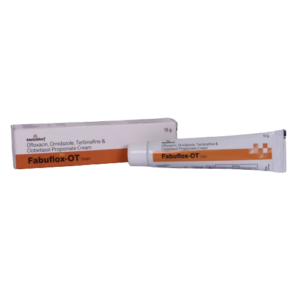CLOTRIMAZOLE + OFLOXACIN + FLUCINOLONE
Clotrimazole: Clotrimazole is an antifungal medication used to treat various fungal infections. It is available as a cream, lotion, powder, or solution and can be used topically on the skin or mucous membranes.
The primary mechanism of action of clotrimazole is the inhibition of an enzyme called 14-alpha demethylase, which is essential for the production of ergosterol, a component of the fungal cell membrane. By disrupting ergosterol synthesis, clotrimazole weakens the fungal cell membrane and leads to cell death.
The dosage and duration of clotrimazole treatment depend on the type and severity of the fungal infection. Generally, it is applied 2-3 times daily or as directed by a healthcare professional. The affected area should be clean and dry before applying the medication.
Clotrimazole is generally well-tolerated, but like any medication, it may have potential side effects. Common side effects include local skin reactions such as itching, burning, and irritation at the site of application. Rarely, allergic reactions may occur, characterized by rash, swelling, or difficulty breathing. If any severe side effects or signs of an allergic reaction occur, medical attention should be sought immediately.
It is important to note that clotrimazole is specifically used for fungal infections and should not be used for other types of infections such as bacterial or viral infections. Additionally, it is not intended for use in the eyes or ingestions.
As with any medication, it is recommended to consult a healthcare professional before using clotrimazole to ensure proper usage and to discuss potential drug interactions or contraindications with other medications or underlying medical conditions.
Ofloxacin: Ofloxacin is an antibiotic medication that belongs to the fluoroquinolone class. It is commonly used to treat various bacterial infections, including respiratory tract infections, urinary tract infections, skin and soft tissue infections, and sexually transmitted infections.
The mechanism of action of ofloxacin involves inhibiting the bacterial DNA gyrase and topoisomerase IV enzymes, which are crucial for bacterial DNA replication, repair, and recombination. By inhibiting these enzymes, ofloxacin interferes with bacterial DNA synthesis, leading to bacterial cell death.
The suggested dose of ofloxacin may vary depending on the type and severity of the infection but is typically 200-800 mg per day, divided into two doses. It is important to follow the instructions provided by the healthcare professional or mentioned on the prescription label.
As with any medication, ofloxacin can cause side effects. Common side effects may include nausea, vomiting, diarrhea, stomach pain, headache, dizziness, and insomnia. It is also possible to experience an allergic reaction characterized by rash, itching, swelling, severe dizziness, and difficulty breathing. Additionally, ofloxacin may increase the risk of tendonitis or tendon rupture, especially in older adults, those with kidney, heart, or lung transplants, and those taking corticosteroids.
Overall, while ofloxacin is an effective antibiotic, it is essential to use it only under the guidance of a healthcare professional and to promptly report any unexpected or severe side effects.
Flucinolone: Flucinolone is a synthetic corticosteroid drug commonly used topically to treat various skin conditions. It is most commonly prescribed as a cream or ointment and is also available as a scalp solution or lotion. Flucinolone is primarily used to relieve itching, redness, and inflammation associated with dermatitis, eczema, psoriasis, and other skin disorders.
The mechanism of action of Flucinolone involves its anti-inflammatory, anti-allergic, and immune-suppressive properties. It works by reducing the production of prostaglandins, cytokines, and other inflammatory mediators, thereby reducing inflammation and alleviating itching and irritation.
The dosage and frequency of Flucinolone use depend on the specific skin condition being treated and the severity of symptoms. Typically, a thin layer of cream or ointment is applied to the affected area once or twice a day, while the scalp solution or lotion should be applied to the scalp as directed by a healthcare professional.
Although Flucinolone is generally considered safe when used as directed, it can cause certain side effects. Common side effects of Flucinolone include skin irritation, dryness, burning, stinging, itching, and allergic reactions. Prolonged and excessive use of the drug can lead to skin thinning, discoloration, stretch marks, and increased vulnerability to infections.
Furthermore, topical corticosteroids like Flucinolone can be absorbed into the bloodstream, especially when used over a large area or for a prolonged period. This can increase the risk of systemic side effects such as adrenal suppression, Cushing’s syndrome, and other hormonal disturbances. It is important to follow the prescribed dosage and duration of treatment to minimize these risks.
As with any medication, it is important to consult a healthcare professional before using Flucinolone to ensure it is the appropriate treatment for your specific condition. They will provide guidance on proper use, potential side effects, and any necessary precautions or contraindications.

